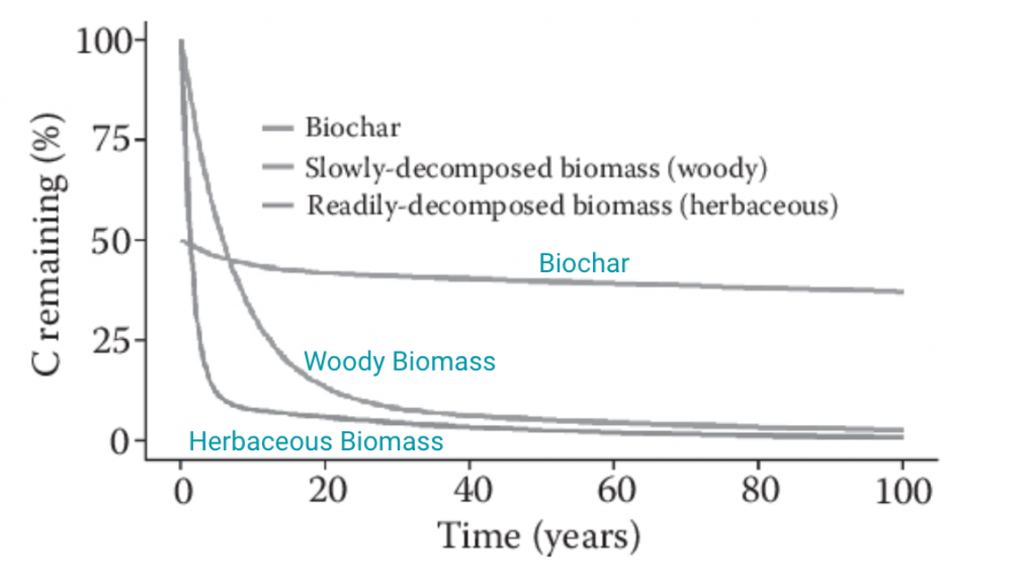Carbon sequestration as a concept has captured the imagination (and invited criticism from skeptics) for some time now. Those words may invoke the highly engineered image of pulling CO2 out of the air and pumping it underground via direct air capture, or purchasing swaths of forests to store CO2 through the carbon cycle.
Here, we’ll focus on biomass based carbon removal. On a basic level, this means that biomass, typically waste biomass, is converted through some process into a more stable form. If this process did not occur, the biomass would produce CO2 over time either through decomposition, burning, or other processes, so converting it to this more stable form at least delays the conversion of organic matter to greenhouse gases.
On a high level, how does it work?
Waste biomass -> process (pyrolysis) -> CO2 removal by stabilizing biomass as biochar, bio-oil, etc.
How to evaluate impact?
Before diving into the impact of these technologies, let’s walk through some principles for evaluating carbon offset projects in general. Some core concepts according to Carbon Direct are additionality, durability/permanence, leakage, reliability of accounting methods, and negative impacts/externalities (“do no harm”). You may encounter different terminology used to describe similar concepts.
Additionality: means that the carbon removal would not have occurred without the purchase of those credits. One example: if a credit for some portion of forest was purchased, but it had already been preserved long before, is the purchase really resulting in additional impact?
Durability: How likely will the carbon be re-released into the atmosphere. For example, a forest in a zone that frequently experiences wildfires would be considered less durable than a forest in an area without that same risk. Permanence is another word that describes this attribute.
Leakage: This term simply means that the emissions haven’t been displaced to another location. For example: if deforestation is prevented at one location, the demand for timber may result in deforestation occurring elsewhere.
Accounting methods: This primarily means 1) how the impact of the projects are quantified upfront and 2) how this impact is monitored over time. In particular, whether the quantification is repeatable, verifiable, and with known + conservative uncertainty estimates is critical. In addition to having stringent accounting methods, many platforms opt to have third party verification of carbon removal processes (here’s an interview with Puro.earth and Energy Link Services, an auditor describing the auditing process)
Negative impacts: Hypothetical example of a negative impact: a carbon removal program that dramatically degrades air quality for nearby communities.
What is the impact of this technology?
So what is the promise of biochar or bio-oil based carbon removal from an impact perspective? The rosiest picture might look like the following scenario: Agricultural waste, which often would have otherwise been burned, is converted through pyrolysis to biochar. This results in negative emissions for hundreds of years while producing a soil additive that improves the drought and pest tolerance of plants. Not to mention the local air quality improvements in agricultural communities or a potential revenue stream for an otherwise troublesome waste product. This is a scenario that biochar advocates will promote, and at face value, seems almost too good to be true. So let’s dig a bit deeper!
Let’s start by considering the impact of this technology from a carbon removal perspective, with a focus on biochar production. Additionality is easier to prove for waste biomass, and one protocol requires that projects involve biomass that would’ve been burned, left to decompose, or landfilled for it to count as additional. For biochar production, about half the carbon embodied in biomass is emitted in the production process, while the other half that would have decomposed over a few decades is stabilized with a durability of hundreds of years. Leakage seems irrelevant in this scenario, as the processing of some waste biomass shouldn’t displace the production of waste biomass elsewhere. As for accounting methods – this is also highly variable based on the degree to which carbon removal is the primary product offering for a given company. For a more in-depth look, here are the criteria that Microsoft and Carbon Direct use as criteria for carbon accounting, including a specific callout for biomass-based sources.
In terms of negative externalities with respect to biochar, a literature review from Brtnicky et al highlights potential negative side effects (impacts on earthworms, the fungi: bacteria balance in soils, and erosion/water retention properties depending on the soil type), and a general need to holistically consider how biochar might interact with a specific type of soil. There is also the possibility of particulate matter impacts from production or from soil application, which diminishes the potential benefit of avoiding crop burning. There is likely more to be learned on this front given the lack of large scale studies on biochar to date.
With that said, research suggests that biochar is generally beneficial for improving water retention, soil health, as well as removing pollutants. Biochar seems to be most effective in soils that are poor or contaminated, which has attracted (at least as of a few years ago) heightened interest from China as a tool to remediate soils, divert agricultural waste which would have been burned, and improve crop yields beyond what chemical fertilizers are capable of.
On the bio-oil front, if stored underground the durability can be on the order of thousands of years. There are potential applications for bio-oil conversion to hydrogen fuel/syngas that the startup Charm Industrial is exploring — these are still carbon negative, though the emissions reduction potential would be impacted by this additional processing.
Perhaps the most common criticism of carbon removal initiatives as a whole is that they distract us from known interventions to reduce our impact (e.g. electrification, renewable energy). Consequently, if carbon removal is to scale, it must do so with high-quality offsets, and without negatively impacting existing efforts.
In summary – technologies that convert waste biomass to biochar/bio-oil and remove carbon in the process may be incredibly compelling as a means to solve several environmental challenges at once. However, these technologies are not a monolith – variations in the feedstock, the processing, and the application (if applicable) of the end product can make a big difference in how impactful this is from a carbon removal perspective and beyond.
Next up – we’ll explore how it works from a technology perspective. Lastly, we’ll take a look at the business case and challenges associated with this space.
———
Many thanks to Katie Holligan from Charm Industrial, Kevin Kung from Takachar, and Tim Preisenhammer from Carbo Culture.
About The Author

Christina manages Sales Enablement programs at Instrumental Inc, a cloud manufacturing optimization platform that partners with electronics brands to improve engineering efficiencies and reduce scrap/waste. Her professional background is in energy efficiency, with roles in revenue operations and sales development at Carbon Lighthouse, following an academic background in environmental engineering. Outside of the climate world, she supports the San Francisco Beacon Initiative as a member of their Associate Board, and in her spare time is an avid enthusiast of hip hop and house dance, the outdoors, and good food.


